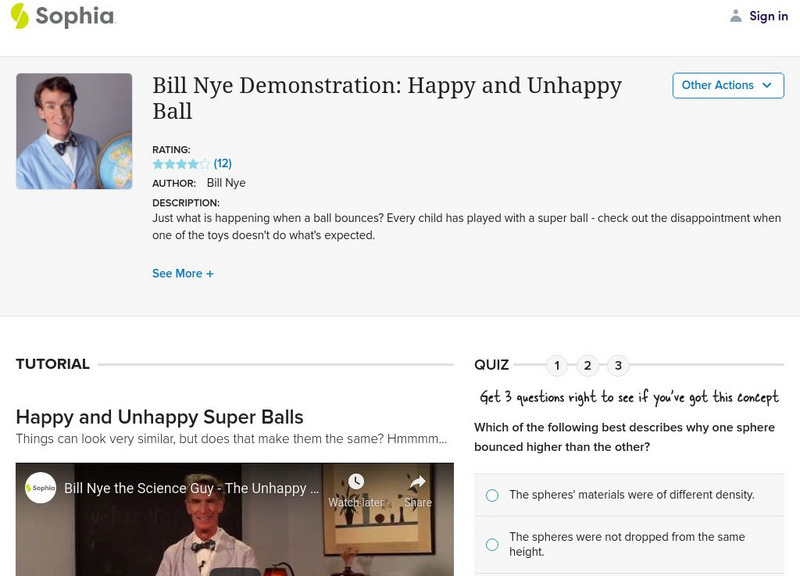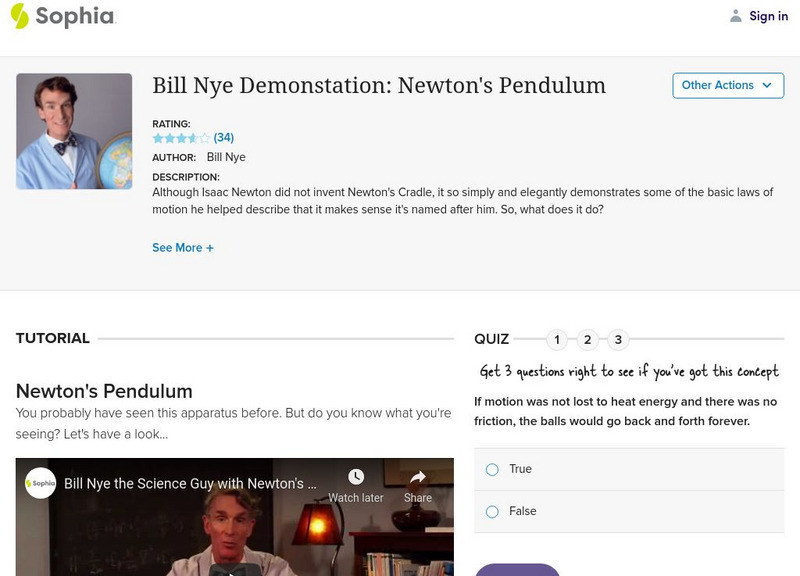Sophia Learning
Sophia: Bill Nye Demonstration: Happy and Unhappy Ball
What happens when a ball bounces? Learn about liquid nitrogen as Bill Nye the Science Guy demonstrates what happens to everyday materials when placed in it. [0:22]
Sophia Learning
Sophia: Bill Nye Demonstration: Newton's Pendulum
Learn about Newton's Pendulum will Bill Nye as you watch this demonstration of some of the most fundamental laws of physics and mechanics. [0:52]
Sophia Learning
Sophia: Bill Nye Demonstration: The Stirling Engine
Learn about the Stirling Engine as Bill Nye demonstrates how it works. [3:24]
Bill Nye
Bill Nye: Blow Out
This tutorial by Bill Nye explains an experiment that demonstrates how the shape of a funnel can affect how air flows through it.
Bill Nye
Bill Nye: Pond, James Pond
This tutorial by Bill Nye explains how to create a tool for looking through the surface of water without being thwarted by reflections.
Bill Nye
Bill Nye: Pages of Inertia
This tutorial from Bill Nye demonstrates the power of inertia by using a dictionary to soften a blow.
Bill Nye
Bill Nye: Falling for Science
This tutorial from Bill Nye shows that gravity pulls on all objects at the same speed. It also demonstrates that, despite this, air resistance can cause certain objects to fall more slowly.
Bill Nye
Bill Nye: My, How Time Flies
In this tutorial, Bill Nye explains how you can use a piece of string and a noisemaker to demonstrate the doppler effect.
Bill Nye
Bill Nye: Current Event
This tutorial from Bill Nye uses ice, salt, water, and food coloring to explain how ocean currents are caused by the flow of heat and salt.
Bill Nye
Bill Nye: Move Mountains
This tutorial from Bill Nye uses newspaper to show how tectonic plates can crush together to create mountains.
Bill Nye
Bill Nye: Twistin' Tornado
This experiment with Bill Nye explains how to make a tornado in a bottle.
Bill Nye
Bill Nye: A Wing and Some Air
This tutorial by Bill Nye helps the learner to understand the concept of pressure. Using a simple paper U, learners can see the effects of low pressure, then learn what's happening on a molecular level.
Bill Nye
Bill Nye: Once in a Mega Moon
This tutorial from Bill Nye explains why the moon appears smaller when it's higher in the sky and presents an experiment that proves that it's all in your head.
Bill Nye
Bill Nye: Marble Madness
In this tutorial, Bill Nye uses marbles to explain momentum and Newton's third law: every action has an equal and opposite reaction.
Bill Nye
Bill Nye: Penny Droplets
This tutorial by Bill Nye introduces the concept of a cohesive force through an experiment involving a penny and droplets of soapy water.
Bill Nye
Bill Nye: Erosion Explosion
This tutorial from Bill Nye demonstrates that freezing water expands, potentially cracking rock and causing erosion.
Bill Nye
Bill Nye: Burn Rubber
This tutorial from Bill Nye explains how to perform a simple experiment with a rubber band. The experiment demonstrates how friction can dissipate energy as heat.
Bill Nye
Bill Nye: Tube Kazoo
This tutorial from Bill Nye explains how to make a kazoo out of a cardboard tube.
Bill Nye
Bill Nye: Acid Attack
This tutorial by Bill Nye explains how to perform an experiment with chalk and weak acids that will help learners to understand erosion. The tutorial demonstrates how acid rain can eat away at rocks and other materials.
Bill Nye
Bill Nye: Go With the Flow
This tutorial from Bill Nye shows how much energy your heart has to expend to pump blood, and demonstrates that it's easier to pump blood downward.
Bill Nye
Bill Nye: Temperature Time Warp
This tutorial by Bill Nye explains why cold-blooded creatures need a warm environment to survive.
Bill Nye
Bill Nye: Listen to This!
In this tutorial, Bill Nye explains how to hear the sound of your heart.
Bill Nye
Bill Nye: Coco Nutty Music
This tutorial from Bill Nye explains how a coconut (and the air inside it) can transform the energy of movement into a variety of interesting sounds.
Sophia Learning
Sophia: Bill Nye the Science Guy Answers: What Is the Doppler Effect?
The Doppler Effect is used to determine the size of the universe as well as predict the weather. Watch this video to get an idea of just what is happening when we experience this scientific phenomenon. [1 min, 03 sec]






